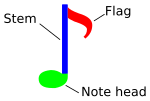| Note |
Rest |
American name |
British name |
Relative value |
Dotted value |
Double dotted value |
Triple dotted value |
 |  | large, duplex long, or maxima[1][2]
(occasionally octuple note,[3] octuple whole note,[4] or octuple entire musical note)[5] | 8 | 
 | 
 | 
 |
 |  | long[2][6][7] or longa[8]
(occasionally quadruple note[9] or quadruple whole note)[4] | 4 | 
 | 
 | 
 |
 |  | double whole note,[10] double note[11][12][13] | breve | 2 | 
 | 
 | 
 |
 |  | whole note | semibreve | 1 | 
 | 
 | 
 |
 |  | half note | minim |  | 
 | 
 | 
 |
 |  or or  |
quarter note | crotchet |  | 
 | 
 | 
 |
 |  | eighth note | quaver |  | 
 | 
 | 
 |
 |  | sixteenth note | semiquaver |  | 
 | 
 | 
 |
 |  | thirty-second note | demisemiquaver |  | 
 | 
 | 
 |
 |  | sixty-fourth note | hemidemisemiquaver |  | 
 | 
 | 
 |
 |  | hundred twenty-eighth note | semihemidemisemiquaver[14][15] (rare) |  | 
 | 
 | 
 |
 |  | two hundred fifty-sixth note | demisemihemidemisemiquaver[4] (rare) |  | 
 | 
 | 
 |





 , ...
, ...



















































































